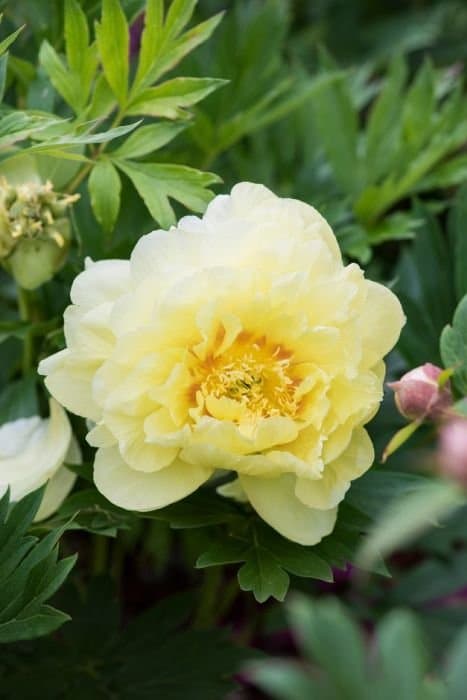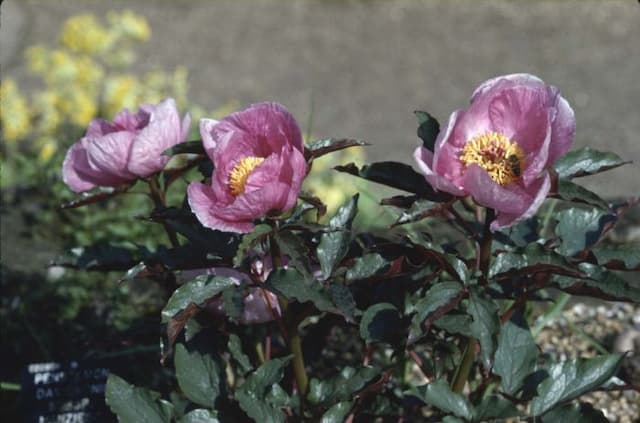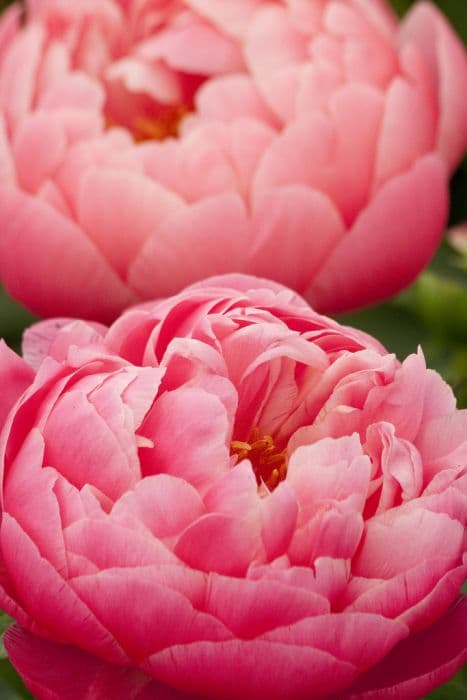Fernleaf Peony Paeonia tenuifolia

ABOUT
The plant known as the fernleaf peony is admired for its unique and attractive foliage and flowers. It has a distinctive appearance, characterized by its finely divided, almost feathery leaves which give it an airy, delicate appearance. The foliage is usually a deep green color, providing a beautiful contrast to the bright, showy flowers. The blooms are a vibrant red and have a classic peony shape, with multiple layers of petals creating a full, rounded form. These flowers are well-known for their striking presence and often have a luminous quality that seems to glow in the garden setting. The fernleaf peony carries its blooms proudly above the foliage, making it a focal point when in flower. The combination of its feathery leaves and bold blossoms makes it a standout plant in any garden.
About this plant
 Names
NamesSynonyms
Fern Leaf Peony, Narrow-Leaved Peony, Balkan Peony.
Common names
Paeonia biebersteiniana, Paeonia tenuifolia var. lithophila, Paeonia tenuifolia var. biebersteiniana.
 Toxicity
ToxicityTo humans
Fernleaf peony (Paeonia tenuifolia), while not widely recognized as a significantly toxic plant to humans, may cause adverse reactions in some individuals if ingested. There is limited information on the specific toxicity of this plant species, but peonies in general can contain compounds like paeonol which could potentially cause gastrointestinal upset, such as nausea, vomiting, or diarrhea. As with many plants, it is advisable to avoid ingestion and to keep them out of reach of children who might be tempted to eat them.
To pets
Fernleaf peony is not typically considered highly toxic to pets, but as with humans, it may still cause mild to moderate gastrointestinal upset if ingested. Symptoms of poisoning in pets could include vomiting, diarrhea, and drooling. While not expected to cause severe toxicity, it is prudent to prevent pets from consuming plant material to avoid these potential adverse effects.
 Characteristics
CharacteristicsLife cycle
Perennials
Foliage type
Deciduous
Color of leaves
Green
Flower color
Red
Height
1 foot 3 inches (38 centimeters)
Spread
1 foot 3 inches (38 centimeters)
Plant type
Herb
Hardiness zones
4
Native area
Eurasia
Benefits
 General Benefits
General Benefits- Ornamental value: Paeonia tenuifolia, commonly known as fernleaf peony, is often grown for its attractive foliage and bright, showy flowers that can enhance the aesthetic appeal of gardens and landscapes.
- Drought tolerance: Once established, the fernleaf peony can be quite drought-tolerant, requiring minimal irrigation and making it suitable for xeriscaping or low-water gardens.
- Cold hardiness: This plant has a notable ability to withstand cold temperatures, making it a suitable choice for gardens in colder climates.
- Attracts pollinators: The flowers of the fernleaf peony provide nectar and pollen for bees and other pollinators, supporting biodiversity and the health of the local ecosystem.
- Longevity: Fernleaf peonies are known for their long lifespan, often living for decades and requiring minimal maintenance, making them a long-term addition to any garden.
- Deer and rabbit resistance: The plant is generally resistant to browsing by deer and rabbits, which helps in maintaining their beauty in areas where these animals are prevalent.
- Cultural significance: Fernleaf peony holds cultural importance in various societies, where it is celebrated in festivals and gardens for its symbolic meanings such as prosperity and happiness.
 Medical Properties
Medical Properties- Antispasmodic: Paeonia tenuifolia can be used to relieve spasms of involuntary muscle.
- Anti-inflammatory: The plant has been traditionally used to reduce inflammation.
- Analgesic: It may have properties that can help alleviate pain.
- Sedative: The root of Paeonia tenuifolia is sometimes used for its mild sedative effects.
- Gynecological aid: Historically, it has been used to address various female reproductive system conditions.
 Air-purifying Qualities
Air-purifying QualitiesThis plant is not specifically known for air purifying qualities.
 Other Uses
Other Uses- Fernleaf peony petals can be used as a natural dye, offering colors from soft yellow to rich orange depending on the mordant used.
- In horticulture, fernleaf peony is utilized as a grafting rootstock for other peony species that are less hardy or have more demanding growth requirements.
- The seed pods of fernleaf peony, once dried, can be used in floral arrangements to add an interesting textural element.
- Fernleaf peony can act as a companion plant in gardens, potentially deterring certain pests with its distinctive fragrance.
- The foliage of fernleaf peony is sometimes used in the art of pressed flower crafts for its intricate and fine leaf pattern.
- Gardeners may use the plant's early spring blooms as an indicator species to signal the optimal time for planting frost-sensitive crops.
- Fernleaf peony is used in landscape design to create attractive color contrasts with its deep red flowers against green foliage.
- Photographers and artists may take inspiration from the striking appearance of fernleaf peony for their works.
- In temperate climate zones, fernleaf peony's foliage can provide seasonal shading for smaller, shade-loving perennials planted nearby.
- The plant is sometimes incorporated into educational botany programs for students to study angiosperm development and flower morphology.
Interesting Facts
 Feng Shui
Feng ShuiThe plant Paeonia tenuifolia, commonly known as Fernleaf Peony, is not used in Feng Shui practice.
 Zodiac Sign Compitability
Zodiac Sign CompitabilityThe Fernleaf Peony is not used in astrology practice.
 Plant Symbolism
Plant Symbolism- Prosperity and Good Fortune - The Paeonia tenuifolia, commonly known as the Fernleaf Peony, is often associated with wealth and success, making it a popular gift in cultures that believe in the plant's ability to bring prosperity to one's home.
- Romance and Love - Fernleaf Peonies symbolize romantic love, owing to their lush, full blooms which represent a hopeful heart and the flourishing of emotion.
- Beauty and Femininity - As with many peonies, the Fernleaf Peony is emblematic of beauty and often correlates with the feminine ideal, celebrating grace and elegance.
- Honor and Respect - In certain traditions, giving a Fernleaf Peony can be a sign of honoring someone and showing deep respect.
- Compassion and Bashfulness - The Paeonia tenuifolia also embodies compassion, with some cultures linking its appearance to a sense of bashfulness due to the story of nymphs turning into peonies to hide their beauty.
 Water
WaterThe Fernleaf Peony should be watered deeply once a week, ensuring to soak the soil thoroughly with approximately 1 to 1.5 gallons of water each time, depending on the climate and soil drainage. During periods of drought or extreme heat, increase watering to twice a week. Ensure the plant is not sitting in water as it prefers well-draining soil, which helps prevent root rot. In the cooler seasons or when rainfall is adequate, reduce watering frequency but do not let the soil completely dry out for extended periods.
 Light
LightFernleaf Peonies thrive in full sun to partial shade positions. They should receive at least 6 hours of direct sunlight per day for optimal growth and flowering. An ideal spot for these plants would be an area where they can enjoy morning sunlight and receive some afternoon shade, especially in hotter climates, to protect them from the intense late-day sun.
 Temperature
TemperatureFernleaf Peonies prefer temperate climates and do best in temperatures between 65°F and 75°F, which promotes robust growth and flowering. They can tolerate winter cold down to about -20°F, making them suitable for growing in USDA zones 3-8. During the active growing season, protect them from extreme heat as temperatures consistently above 86°F can negatively impact the plants.
 Pruning
PruningFernleaf Peonies should be pruned to remove any spent flowers after blooming to conserve the plant's energy for the next season. Cut back the foliage in the fall, after the first frost has caused the leaves to yellow, reducing the plant tissue to ground level, which helps to prevent disease. Pruning is typically done annually during these times.
 Cleaning
CleaningAs needed
 Soil
SoilFernleaf Peony thrives in well-draining soil with a pH of 6.5 to 7.0. For the best soil mix, combine one part garden loam, one part compost or well-rotted manure, and one part perlite or coarse sand to ensure good drainage and fertility.
 Repotting
RepottingFernleaf Peonies rarely need repotting and prefer to be left undisturbed. They can be left in the same spot for 10 years or more before they may require division due to overcrowding.
 Humidity & Misting
Humidity & MistingFernleaf Peony does well in average garden humidity levels and does not require any special humidity adjustments. Just ensure it is planted in an area with good air circulation to prevent any humidity-related issues.
 Suitable locations
Suitable locationsIndoor
Grow Fernleaf Peony indoors in bright light, with cool temperatures.
Outdoor
Plant Fernleaf Peony in sunny spot, well-draining soil, avoid wet feet.
Hardiness zone
4-8 USDA
 Life cycle
Life cyclePaeonia tenuifolia, commonly known as the fern leaf peony, begins its life cycle as a seed which requires a period of cold stratification to break dormancy. Upon germination in spring, the seedling develops a small tuberous root system and a set of true leaves. Throughout the years, the plant forms a larger root system and numerous stems with the distinct finely divided, fern-like leaves. The fern leaf peony reaches maturity and starts to produce its characteristic deep red solitary flowers each spring, which are pollinated by insects, primarily bees. After pollination, the plant forms a follicle-type fruit containing seeds that will be dispersed to start new plants. In late summer, the above-ground foliage dies back, and the plant enters dormancy, retreating to the underground tuber until the next growing season.
 Propogation
PropogationPropogation time
Spring
Propogation: The most popular method of propagating the Paeonia tenuifolia, commonly known as fern leaf peony, is through division. This process is best carried out in the fall after the plant has finished flowering and the leaves begin to die back. To propagate by division, carefully dig up the plant, making sure to keep a generous amount of soil around the roots to protect them. Using a sharp knife or spade, divide the root ball into sections, ensuring that each section has at least 3-5 eyes, which are the buds from which new growth will emerge. Replant the sections at the same depth they were previously growing, spacing them about 3 feet (approximately 0.9 meters) apart to allow for future growth. Water the newly planted divisions thoroughly to settle the soil around the roots and help establish them. The divisions should be mulched lightly to conserve moisture and protect them over the winter.









